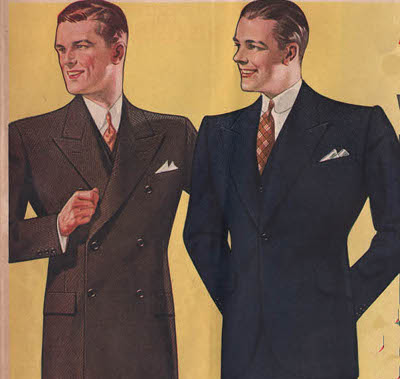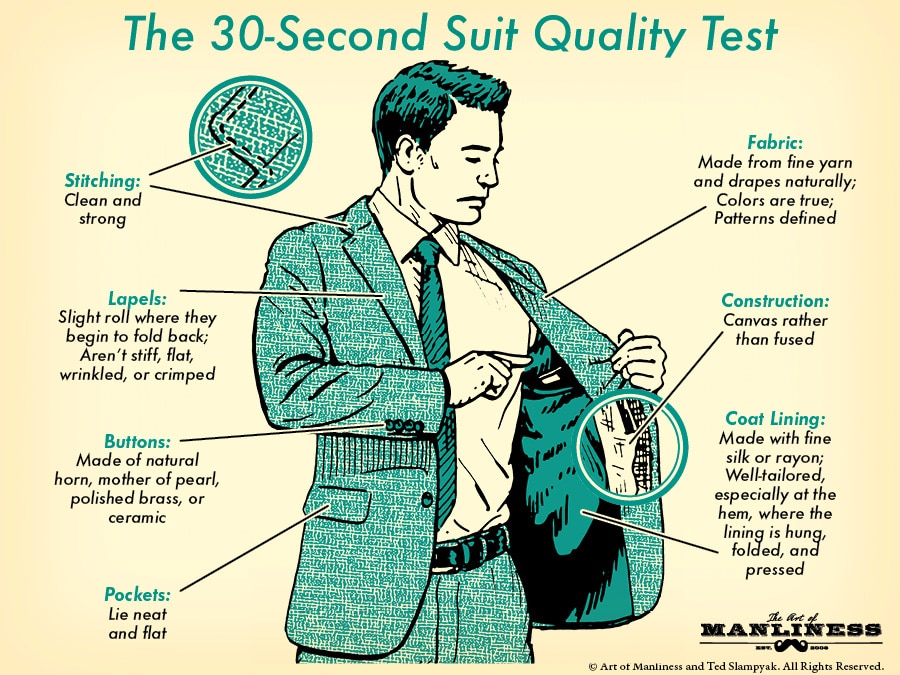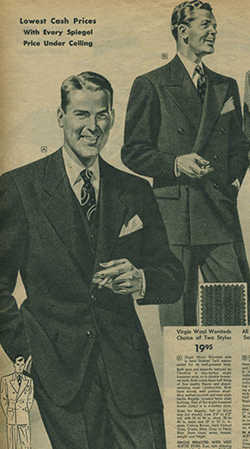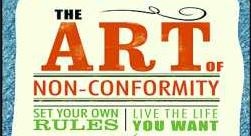
Editor’s note: The AoM Community’s resident style hobbyist, Leo Mulvihill, posted a series of posts on the Community blog to help men understand more about buying and wearing a suit. We’ll be publishing his entries here every other week. Thanks for sharing your sartorial knowledge, Leo!
Those of you who are active on the forums are aware that I believe every man should own a fine suit. As men, all of us are going to need suits, whether for interviews, work, or socializing- life occasionally demands it of us. Because we’ll all need a good suit for such occasions, we might as well make the investment in a quality suit that will provide us years of enjoyment.
Today, I’m going to start the first of a series of articles on how to find yourself that high quality, all-purpose suit.
I’ll begin by saying that price is not necessarily indicative of a suit’s quality. At least equal of weight with the elements of cut, fabric pattern and fabric quality is construction.
Today, we’re going to focus on the construction of a jacket – namely, whether a jacket is canvassed or fused.
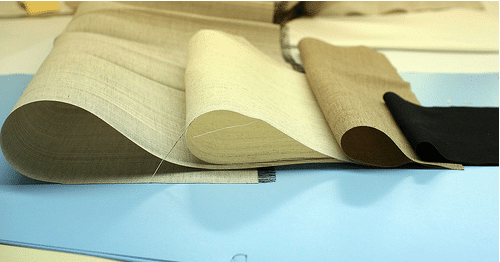
In this picture, taken from the blog Made by Hand- The Great Sartorial Debate, we can see an example of three different horsehair canvassing materials on the left, versus fusible on the right. Note the fullness of the canvas materials, while the fusible appears limp by comparison.
Canvassed Jackets
A Little Bit of Suiting History
Traditionally, men’s suits were constructed with a layer of horsehair canvas underneath the wool fabric shell. This canvas holds the shape of the suit and keeps it from sagging or deforming, much like the foundation of a house keeps it upright. The canvas is cut to the jacket’s shape, then the wool is stitched to the canvas. Over time, as you wear the jacket, the canvas conforms to your body’s shape, creating an excellent fit.
The canvas lining allows the suit fabric to drape naturally, allowing a clean, well put-together look.
Fused Jackets
Many suit manufacturers, as an effect of increased production, no longer use a canvas interlining in their jackets. Rather, a fusible interlining is glued to the wool shell of the suit. And while this does an adequate job of keeping a jacket’s shape, it often creates an unnatural stiffness in the jacket, making a fused jacket appear lifeless compared to a similar canvassed coat.
It’s not just budget brands that construct jackets in this fashion. Many designer labels construct their suit jackets this way to save themselves money.
What is sometimes problematic with fused jackets is the fact that the glue degrades over time, or may come unstuck during the dry-cleaning/pressing process. Where the wool detaches from the fused backing, the fabric ripples around the chest and lapels, a phenomenon known as “bubbling.” Unfortunately, there is no way to fix this problem once it’s occurred – as I’ve learned the hard way.
Nowadays, fusing technology has improved to the point where you may never experience bubbling problems, but there’s always the chance that this might occur.
Half-Canvassed Jackets
Between the two extremes lies a compromise – the half-canvassed jacket. Half-canvassed jackets have canvas material running only through the chest and lapels of the coat. Past that point, the jacket is fused.
Half-canvassed jackets have several benefits. First, they generally have a lower price than a similar fully canvassed jacket. Less handiwork means a lower overall cost to you.
And because the top half of the jacket is not fused you’ll not run into any bubbling problems as you might in a fused jacket. This adds to the lifespan of the garment.
Finally, the canvassing provides the proper base for the jacket to drape naturally across your chest, rather than appearing stiff and lifeless as many fused jackets do.
Let’s see the difference between the three different types:
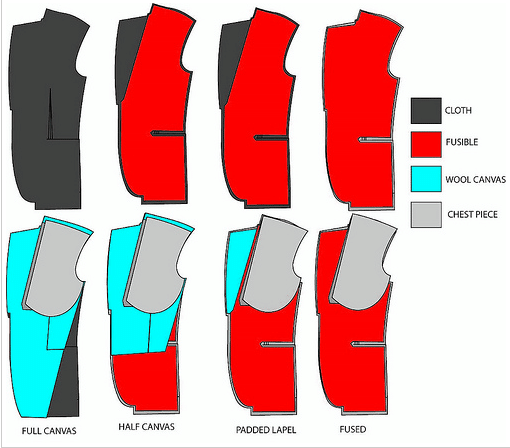
First off, I’d like to give credit to JefferyD of StyleForum for this excellent diagram.
In the full canvas garment, you can see how the jacket is composed entirely of cloth and horsehair canvas. The fabric is stitched directly to the canvas.
In a half-canvassed garment, fusible extends the entire length of the coat. However, the garment is stitched to the canvas material, assisting in the proper shaping and providing life to the coat.
In the fused jacket all the way to the right, the fusible interlining is glued the entire length of the coat.
How to Tell a Canvassed v. Fused Jacket
Pinch Test
The pinch test is an excellent way to determine whether a jacket is canvassed or fused.
First, pinch the fabric on the sleeve of the jacket to get a feel for the wool’s thickness (sleeves are not canvassed). Then, pinch the cloth below the bottom buttonhole from both the inside and out. Gently pull the layers apart. If you feel a third layer inside, then the coat is fully canvassed.
If you don’t feel a third layer, or the fabric feels stiffer and thicker than that of the sleeve, the jacket is more than likely fused.
Lapel Test
Note that fusing has gotten a lot better nowadays and is not always as stiff as it’s been in prior years, making it a little more difficult to determine whether a jacket is indeed canvassed. Accordingly, use your eyes to help figure it out.
In a canvassed jacket, most of the stitching attaching the canvas and wool is behind the lapels. If you look carefully on the reverse side of a jacket’s lapel, you can see the tiny stitches holding the layers of fabric together. A fused jacket will have no such stitching. This can be very difficult to see, often virtually invisible under normal lighting.
What Does This Mean to me Anyway?
The real reason to buy a good, canvassed suit is for love of dressing well. Because of advancing construction technology, there isn’t necessarily a huge advantage for canvassed jackets anymore: a good fused jacket can last awhile and is often much, much cheaper than a similar canvassed jacket.
However, I stand by my preference of canvassed jackets for three reasons:
1. Canvassed jackets look better on you.
2. Higher-end manufacturers using canvassed construction tend to have a better mastery of style and cut.
3. Canvassed jackets generally last longer.
This makes sense – those companies willing to invest the time in making a better-quality suit also have the history to understand how a suit should be properly cut and constructed. And if you’re going to make the investment in a suit, you want to look your best.
Know Your Market
With all of this in mind, understand that it’s less important where you buy something, and more important to understand the different markets to which suits are sold.
Companies like Jos. A. Bank and Men’s Wearhouse sell to the office-wear crowd (people who wear suits because they have to). These suits are generally cheaply made and won’t last.
Fashion designers sell suits as design statements for those interested in appearing the most fashionable, but just because a suit’s designer does not mean that it’s quality; often you’re paying for the label itself.
Finally, there are companies that sell to those who appreciate classic, high-quality suits. Usually companies in this last category have control over their own production and have been doing what they do for a long time (Canali, Brooks Brothers, Brioni, Kiton, Isaia, etc.).
Many consumers fail to see these distinctions and simply construe a better-worse spectrum, most often with designer suits at the top. But now you’re armed with the knowledge to know better.
Where Can I Go for a Canvassed Suit?
Many quality retailers still stock canvassed and half-canvassed suits that won’t cost an outrageous amount of money. Here are a few of my recommendations for those of you starting out on your quest.
Brooks Brothers
Brooks Brothers is a bastion of American menswear. Founded in 1818, they’ve provided clothing for every American man, from college students to businessmen to American presidents (they even made TR’s uniform for the Spanish-American War). Their 1818 line is half-canvassed, available in three different cuts (from slim to more traditional), and priced very competitively.
Their Golden Fleece line is fully canvassed and substantially more expensive that the 1818.
Ralph Lauren
If you have a Ralph Lauren boutique in the area, check them out. Ralph Lauren has several different suiting lines as well – Polo Ralph Lauren (Blue Label), Ralph Lauren Black Label, and Ralph Lauren Purple Label – in increasing quality and price. The price tags of these suits usually reflect Ralph Lauren’s designer status, but they are often available on sale for a great percentage off retail price.
Purple Label is generally made in Italy and generally more conservative in appearance. Black Label is all Italian, slim, and fashion forward. Polo Ralph Lauren is the more affordable and often conservative line of the three.
Avoid Lauren Ralph Lauren (green label) suiting, often available in department stores. It has nothing to do with the Ralph Lauren company – another company who licensed the name manufactures it.
Local Tailors
You can get a custom suit from a local tailor, if you’re willing to pay a bit more. Many local tailors offer in shop made-to-measure, or if they’re more accomplished, full bespoke. The difference between the two being that made-to-measure works from a general pattern adjusted for your size, whereas bespoke involves drawing individual patterns for each customer and several intermediate fittings to get it all right.
Online Made to Measure
There are many online made-to measure companies as well, including A Tailored Suit and Thick As Thieves. While these companies offer a fantastic bang for your buck, I don’t generally recommend online MtM for a first suit. Too often, there are so many variables and room for error that the result is less than ideal. Ready to wear companies have invested a lot of time into perfecting their patterns to suit a variety of body types and are often the best choice for the beginning suit buyer.
Traveling to Asia?
If you have money to burn and enjoy traveling, Hong Kong has a great selection of tailors who can tailor custom suits relatively inexpensively. Several of these tailors also travel in circuits around the globe, so keep an eye out for appointments in your city.
Well folks, that’s it for now. I hope that you learned something to help you in your suit search.
If you have any questions, feel free to ask. I can’t promise to have all the answers, but I’ll do what I can.
Stay tuned for the next installment of the Art of Manliness Suit School.
_______________
Art of Manliness Suit School: Part 2 – The Alterations Every Man Needs
Art of Manliness Suit School: Part 3 – A Primer on Suit Buttons


